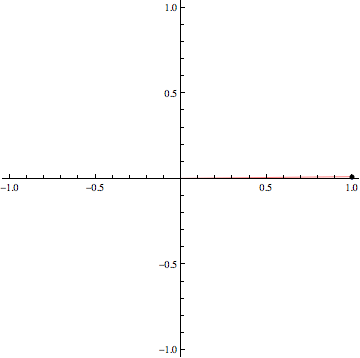Comments: Today we explored how gradients can be used to
find vectors normal to a surface with equation \(f(x,y,z)=c\) at a point P.
In particular, we think of the equation as giving us a level surface for the
function \(f(x,y,z)\) so that \(\nabla f_P\) is a vector orthogonal (and
hence normal) to the level surface of \(f\) that contains P.
We also recalled the fact that differentiability for functions on one
variable, \(f(x)\), at a point \(P= x_0\) means that the "zoomed in" portion
of the graph of the function near P is indistinguishable from a line -- the
tangent line to \(f\) at \(x_0\). The linearization of the
function at the point \(x_0\) is the related function \(L(x)=
f(x_0)+f'(x_0)(x-x_0)\). We then extended this idea to functions on two
variables, \(f(x,y)\), and noted that the two dimensional analog of
differentiability is that the "zoomed in" portion of the graph of
\(z=f(x,y)\) near a point \((x_0,y_0) \) will be indistinguishable to a plane
-- the tangent plane of \(f\) at the point \((x_0,y_0) \).
Although the existence of both partial derivatives at a point is not
sufficient to guarantee a tangent plane (i.e., differentiability), we noted
that a function will be differentiable at \((x_0,y_0) \) if there is an open
set containing \((x_0,y_0) \) for which the partial derivatives of \(f\)
exist at every point in that open set. In this case, the linearization of the
function \(f\) at \((x_0,y_0) \) is the related function
\(L(x,y)=f(x_0,y_0)+f_x(x_0,y_0)(x-x_0)+f_y(x_0,y_0)(y-y_0)\). The graph
\(z=L(x,y)\) is the tangent plane to \(f\) at \((x_0,y_0)\).
I then passed out a handout designed to help you
see that differentiable functions have gradients at every point in their
domain and that we can use level sets to draw enough gradients to have a very
good understanding of how a function on two variables behaves. Tomorrow, we
will focus on differentials and how to use them in a more modern way than is
stressed in the textbook.
Here is a link to the
results of the midcourse survey. Comments are paraphrased and in boldface
font. Obvious results are: five people want more in-class examples; one
person does not find the computer generated graphics useful; one person does
not find the topics/text/tomorrow or daily notes information useful. Two
comments (each from only one person) worth discussion are: have longer due
dates for homework and laughter can be a bit disruptive.
Exam #2 will be on Thursday March 7. I will supply a list
of exam objectives either at the end of this week or over the weekend.
